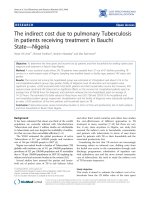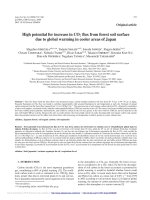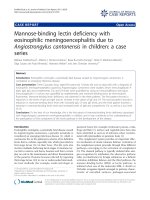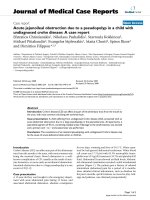Factors influencing economic losses due to milk fever in dairy farms
Bạn đang xem bản rút gọn của tài liệu. Xem và tải ngay bản đầy đủ của tài liệu tại đây (179.57 KB, 4 trang )
Int.J.Curr.Microbiol.App.Sci (2020) 9(8): 1410-1413
International Journal of Current Microbiology and Applied Sciences
ISSN: 2319-7706 Volume 9 Number 8 (2020)
Journal homepage:
Original Research Article
/>
Factors Influencing Economic Losses due to Milk Fever in Dairy Farms
V. Senthilkumar*
Department of Animal Husbandry Economics, Tamil Nadu Veterinary and Animal Sciences
University, Veterinary College and Research Institute, Namakkal – 637 002, India
*Corresponding author
ABSTRACT
Keywords
Milk fever,
Metabolic Diseases
and Multiple linear
function
Article Info
Accepted:
15 July 2020
Available Online:
10 August 2020
Milk fever is the common disease and one among the important metabolic disorder in
lactating dairy animals. It is an afebrile hypocalcaemic disease of cattle usually associated
with immediately after parturition and initiation of lactation. Milk fever is a metabolic
disease occurring in dairy animals during parturient period and management is
economically most important, as it results in not only reduction in milk production but also
loss of animals. For the study, 83 milk fever affected dairy animals (both cows and
buffaloes) were selected through multistage random sampling technique from Namakkal
and Karur districts of Tamil Nadu. Data were collected from the respondent farmers
through personal interviews, using pretested interview schedule. A multiple linear
regression function model was fitted to study the factors influencing economic loss due to
milk fever in dairy farms. The variables viz., late stage of lactation, season summer, season
winter, number of days illness and milk yield included to explain the variations in the
losses due to milk fever were found to be significant at one per cent level (P≤0.01). The
other factor mid stage of lactation was found to be significant and negative at five per cent
level (P≤0.05). The coefficient of average daily milk yield per animal (5.703) indicated
that the economic loss due to milk fever would increase by Rs.5.703 per affected animal as
the average daily milk yield of the animal increases by one litre of milk from its mean
level.
Introduction
The livestock sector particularly dairy
farming plays a significant role in securing
the livelihood of rural farmers by providing
income and employment generation in rural
areas. However, this sector is facing several
disease problems due to introduction of exotic
germ plasm for higher productivity and
changing global climate which cause huge
economic loss resulting from mortality and
low productivity of animals (Singh and
Shivprasad, 2008). Livestock diseases
particularly metabolic disorders in dairy
animals cause reduction in production
efficiency leading to severe economic losses
(John Christy and Thirunavukkarasu, 2006).
Milk fever is an afebrile hypocalcaemic
disease of cattle usually associated with
immediately after parturition and initiation of
lactation. This disease has been known by a
number of terms namely parturition paresis,
1410
Int.J.Curr.Microbiol.App.Sci (2020) 9(8): 1410-1413
milk fever, parturient apoplexy, eclampsia
and paresis peurperalis (Littledike et al.,
1981). Further, increasing production of milk
after calving places an enormous demand for
glucose and minerals at a time when feed
intake would not have reached its peak,
leading to draining of glucose and calcium
from the blood and leaving the milch animal’s
metabolism under severe stress, as transitions
to lactation (Bethard and Smith, 1998).
Clinical hypocalcaemia can occur before,
during or after calving (Bar and Ezra, 2005).
Milk fever is a metabolic disease occurring in
dairy animals during parturient period and
management is economically most important,
as it results in not only reduction in milk
production but also loss of animals
(Thirunavukkarasu et al., 2010). Analyzing
the various causative factors involved in milk
fever is important to help in understanding the
effective management and prevention of this
disease, which can aid in losses to be avoided
in dairy farming. Keeping the above facts in
view, this study was conducted in Karur and
Namakkal districts of Tamil Nadu State.
Materials and Methods
For the study, 83 milk fever affected female
bovines were selected through multistage
random sampling technique from Namakkal
and Karur districts. Affected dairy animals
were identified by case registers of veterinary
dispensaries and clinics of Veterinary College
and Research Institute, Namakkal and
practicing private veterinary doctors in both
districts. This study is based on the primary
data collected through personal interviews
with the farmers using pre tested interview
schedule.
The data collected from the sample
respondents included information on size of
animal holdings, breed, parity, stage of
lactation, frequency of occurrence, stage of
calving, feeding practices, number of days
illness, system of rearing, milk yield, season
of disease occurrence and production losses
were also collected.
A multiple linear regression function of the
following form was fitted to study the factors
influencing economic loss due to milk fever
in dairy farms.
Yj = a + b1X1 + b2X2 + b3X3 + b4X4 + b5X5 +
b6X6 + b7X7 + b8X8 + b9X9 + Uj
Where, Yj = Per animal annual economic loss
due to milk fever
a, bi = Coefficients to be estimated
Uj = Error term
The description of variables used in multiple
linear regression analysis for milk fever in
dairy animals is presented in Table 1.
Results and Discussion
Based on the results of ANOVA, linear
regression models were fitted for milk fever
to assess the contribution of different factors
to the economic loss arising due to milk fever
in dairy animals and the results are presented
in Table 2.
The coefficient of multiple determination
(adjusted R2) in the model fitted for milk
fever was 0.553, indicating that the model
was a good fit and that about 55.30 per cent of
the variation in the dependent variable, i.e.,
economic losses due to Milk fever could be
explained by the chosen independent
variables. The ‘F’ statistic also showed that
the fitted regression model was found to be
significant.
The variables viz., late stage of lactation,
season summer, season winter, number of
days illness and milk yield included to explain
the variations in the losses due to milk fever
1411
Int.J.Curr.Microbiol.App.Sci (2020) 9(8): 1410-1413
were found to be significant at one per cent
level (P≤0.01). The other factor mid stage of
lactation was found to be significant and
negative at five per cent level (P≤0.05).
Table.1 Description of variables used in multiple linear regression analysis for milk fever in
dairy animals
Explanatory variables
Stage of lactation a
Breed
Parity (Order of lactation)
Season b
Number of days illness
Average daily milk yield
Species of dairy animal
a
Levels
Early stage; Mid stage;
Late stage
Non-descript;
Crossbred cow /
Graded buffalo
Continuous
Summer; Winter;
Monsoon
Continuous
Continuous
Cow; Buffalo
Specifications
1-if Mid; 0-Otherwise
1-if Late; 0-Otherwise
1-Crossbred Cow/
Graded Buffalo; 0Otherwise
In number of calving
1-if Summer; 0Otherwise
1-if Winter; 0-Otherwise
In number of days ill
Litres per day
1-if Cow; 0-Otherwise
Xi
X1
X2
X3
X4
X5
X6
X7
X8
X9
reference category: Early lactation; b reference category: monsoon
Table 2 Regression coefficients of linear models fitted to analyse the factors influencing milk
fever in dairy animals
(Dependent variable: Milk fever in dairy animals)
Variables
Constant
Breed
Order of lactation
Stage of lactation 2
Stage of lactation 3
Milk yield
Season summer
Season winter
Number of days illness
Species
Coefficient of multiple
determination (adjusted R2)
F statistic
N
* - Significant at five per cent level (P≤0.05)
* *- Significant at one per cent level (P≤0.01)
Figures in parentheses indicate standard error
1412
Coefficients
549.537 (38.030)
10.642 (20.936)
-6.628 (6.408)
-52.410* (21.228)
-63.670** (23.162)
5.703** (1.920)
37.302** (11.745)
-35.621** (11.410)
83.974** (16.388)
-6.211 (18.356)
0.551
12.292
83
Int.J.Curr.Microbiol.App.Sci (2020) 9(8): 1410-1413
The coefficient of average daily milk yield
per animal (5.703) indicated that the
economic loss due to milk fever would
increase by Rs.5.703 per affected animal as
the average daily milk yield of the animal
increases by one litre of milk from its mean
level (Thirunavukkarasu et al., 2010). The
coefficient of duration of illness (83.974)
indicated that as the duration of illness
extends by one day from its mean level, the
economic losses are liable to increase by
Rs.83.97. The coefficient of stage of lactation
and coefficient of season were found to be
significant and had influence over occurrence
of milk fever.
In conclusions the results of this study, as it
analyzing the factors involved in milk fever
dairy farms, will aid the researchers, planners
and policy makers to design suitable policy
decisions
and
appropriate
preventive
measures to combat this disease. Creating
awareness about the important of this disease
and nutritive values of various commonly
used feed ingredients at field level through
extension programmes to minimize this
disease loss.
References
Bar, D and E. Ezra. 2005. Effects of common
calving diseases on milk production in
high-yielding dairy cows. Israel
Journal of Veterinary Medicine, 60(4):
34-42.
Bethard, G and J.F. Smith. 1998. Controlling
milk fever and hypocalcaemia in dairy
cattle: use of Dietary Cation-Anion
Difference (DCAD) in formulating dry
cow rations. Technical report 31,
Agricultural
Experiment
Station,
Cooperative
Extension
Service,
College of Agriculture and Home
Economics, New Mexico State
University.
John Christy, R and M. Thirunavukkarasu.
2006. Emerging importance of animal
health economics–a note. Tamil Nadu
Journal of Veterinary and Animal
Sciences, 2(3): 113-117.
Littledike, E.T., J.W. Young and D.C. Beitz.
1981. Common metabolic diseases of
cattle: ketosis, milk fever, grass tetany
and downer cow complex. Journal of
Dairy Science, 64: 1465.
Singh, B and Shiv Prasad. 2008. Modelling of
economic losses due to some
important diseases in goats in India.
Agricultural Economics Research
Review, 21: 297-302.
Thirunavukkarasu, M., G. Kathiravan, A.
Kalaikannan and W. Jebarani. 2010.
Quantifying economic losses due to
milk fever in dairy farms. Agricultural
Economics Research Review, 23: 7781.
How to cite this article:
Senthilkumar, V. 2020. Factors Influencing Economic Losses due to Milk Fever in Dairy
Farms. Int.J.Curr.Microbiol.App.Sci. 9(08): 1410-1413.
doi: />
1413









